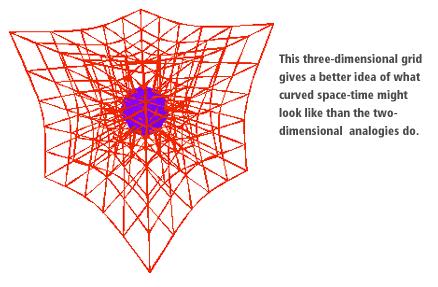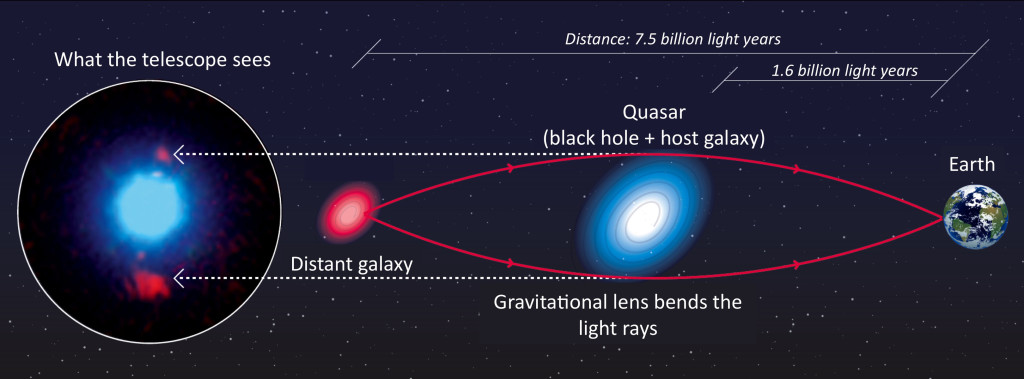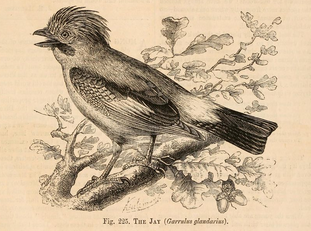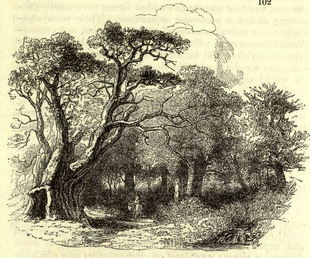-

-

-

-

-

-

-

-

-

-

-
-

-

-

-

-

-

-

-

-

-

-

-

-

-

-

-

-

-

-

-

-

-

-

-

-

-

-

-

-

-

-
-

-

-
 TOTW: Google's Project Ara Modular Phone May Be The Future Of SmartphonesOctober 30, 2014
TOTW: Google's Project Ara Modular Phone May Be The Future Of SmartphonesOctober 30, 2014 -

-

-

-

-

-

-

-

-

-

-

-

-

-

-
-
-

-

-

-

-

-

-

-

-

Posts tagged science
How Einstein Predicted The Future: A Story Of Gravitational Lensing
08 years
It’s 1916. A relatively unknown (see what I did there) physicist named Albert Einstein has just released a couple of papers about his very weird but interesting Theory of Relativity, and you can’t decide what you want to think about it. The papers have gained Einstein some popularity in the physics community, many agreeing with what he had to say, some disagreeing. Many years later, once the theory was proven through observations of Mercury’s orbit and other various tests throughout the years, Einstein became an internationally renowned, scientific rock star. Now it’s 2015, 100 years after Einstein introduced his ingenious theory. Einstein is still known as the epitome of human intelligence, and his fame and prestige is as widespread as ever, while the repercussions of his work still permeate the modern scientific landscape – so much so that it allows us to predict the future.
Before we get into the whole time travel stuff, it might help to understand more about what exactly General Relativity is. Despite the fact that Einstein is known as a genius worldwide, the specifics of what his theory actually means are lost on most people who haven’t extensively studied it. Whereas we see time and space as distinct, Einstein thought of them as one thing: “spacetime”. (Try not to think too hard about that merging space and time part.) Where Newton thought that there was this mysterious force called gravity that radiated from anything with mass, Einstein had his own theory, which assumed that, rather than using an enigmatic force to pull nearby things to it, objects with mass (especially large ones) curve spacetime. So, when following the easiest path through spacetime, which all objects naturally do, objects near another large object, say the Earth, naturally get pulled toward it. Now there’s a proposition for you: just by existing, you disrupt the fabric of the universe by curving it.
But it’s true, and as I wrote earlier, general relativity has been confirmed through many different experimental observations over the years. One such confirmation came through the discovery of a phenomenon that Einstein predicted in his papers, but never expected to be observed because of its rarity: gravitational lensing. Gravitational lensing occurs around large objects, though not just large as in the Earth or even the Sun, but large as in supermassive galaxy clusters. As it turns out, Einstein’s idea that things with mass curve spacetime not only explains gravity but also implies gravitational lensing. Because large objects curve spacetime, really large objects like galaxy clusters curve spacetime much more, enough so that light coming from behind the cluster becomes visibly curved.
The light coming from an object directly behind the galaxy cluster, a smaller galaxy cluster for instance, will get curved around the cluster in the foreground and scattered away from its previous course, potentially toward the awaiting telescopes here on Earth. Einstein thought it would be unlikely that such a situation that we could observe on Earth would happen anytime soon; that a gravitationally lensed light source would happen in our direction, that the light would be lensed toward us, and that we’d be ready to receive it. He happened to be wrong on this one, as we have observed many instances of gravitational lensing in action over the years, the image below being one such example.
And one more thing: gravitational lensing essentially peers into the past. Because light takes time to travel to Earth, the farther away you look in a telescope, the further back in time you see. This doesn’t affect us in day to day life, but with large space telescopes like Hubble we can see billions of year into the past. Since gravitational lensing acts very similar to a telescope, taking light from far away and magnifying it, the foreground galaxy cluster acting as the lens, we can legitimately say that gravitational lensing peers into the past.
So, aside from being a fascinating phenomenon and an example of General Relativity in action, gravitational lensing has been used over the years be a tool to peer into the universe’s history, and recently, into the future as well. Researchers at the University of California, Berkley, published a paper in Science that detailed their observations and subsequent research on a supernova they named Refsdal after Norwegian astronomer Sjur Refsdal. Patrick Kelly, an astronomer at the university, noticed something odd while looking through photos taken by the Hubble Space Telescope. What Kelly noticed was what’s called an Einsteinian Cross, such as the one below:
An Einsteinian Cross occurs when gravitational lensing bends the light around a galaxy cluster and toward Earth in a way that projects 4 images of the same star around the forefront galaxy in the shape of a cross. In this case, the star was actually a supernova, when a star explodes in a fantastic burst of energy and light. Supernovae are one of the biggest and brightest events in the universe, releasing up to around 1044 joules, or the total energy released by an average star in it’s 10 billion year long lifetime. But supernovae are fairly rare, so you can imagine how lucky it was to observe a gravitationally lensed one.
As it turns out, Refsdal is actually 9 billion light years away, and since the supernovae is a one-time event, we can conclude that gravitational lensing has allowed us to photograph the supernovae 9 billion years in the past, almost three-quarters of the way to the beginning of the universe. Because of an odd phenomenon in spacetime, and lucky happenstance, we get to observe the death of a star billions of years ago. And not only that, but we get to see it multiple times.
While in most drawings and explanations of gravitational lensing, we see the light being bent around a perfectly spherical bubble of gravitational attraction, whereas in reality that gravitational bubble can be warped. Essentially, the path around the cluster can differentiate the light paths enough so that some take longer than others. The direct effect of this differentiation is that we get to see the supernova over and over again, as the light paths keep hitting us at different times. We only observed one so far, in November of this year, but we can assume that we missed the explosion being replayed twice in the 20th century, and we can even predict that another will appear in the next 1-4 years.
And there we have it! We have successfully predicted the future, although admittedly in a fairly specific way. But the usefulness of this situation spans more than just the coolness of predicting the future and seeing into the past. “It’s a wonderful discovery,” said Alex Filippenko, a professor of astronomy at Berkley and member of Kelly’s team. “We’ve been searching for a strongly lensed supernova for 50 years, and now we’ve found one. Besides being really cool, it should provide a lot of astrophysically important information.” For instance, with more research the scientists may be able to gain insight into how supernovae work, how gravitational lensing work, in turn the nature of spacetime, and even how dark matter works, which makes up a large portion of the gravitational pull affecting the light from the supernova’s original explosion. Discoveries like these are not only exciting and interesting, but they allow us to continually understand more and more about the world, and universe, around us.
Science Journals May Not Be As Reliable As We Thought
09 years
Science journals are a great way to learn about discoveries in a wide variety of fields, and reading them keeps you scientifically literate and up-to-date on new advances. Journals such as Nature and Science have become increasingly popular outside their core “hard science” constituencies, partly due to successful outreach efforts including new podcasts, videos, and free web content. These growth initiatives have not diluted the top-tier scientific stature of the publications –they remain at the pinnacle of the scientific community. Because of the journals’ exclusivity and reputation, most readers naturally assume the findings featured in their articles are true. But the reliability of published scientific research has come under scrutiny recently, ironically in a paper published in Science itself that called into question papers published in leading psychology journals.
The study was simple. They would take 100 papers published in top psychology journals and try to replicate their results. Replication is a keystone of science: if I get one result and you get another doing the same study or experiment, then we can’t say for sure that either my or your result is true. The scientific method has included replication for 500+ years, all the way back to the Muslim scientists of Baghdad. So, when modern scientists replicate old psychology studies, you can expect them to get the same result, right?
Well, that’s the problem. Many of these studies are so hard to replicate that the effort is never even attempted. Part of the problem is that scientists won’t get a headline study published with a title like “Blah Blah Study From A Year Ago Done Again And The Same Thing Happened!” New, exciting studies are what get published, and that’s what a scientist wants: to get published. But let’s assume that not all researchers are like this, and some do science purely with a goal of advancing and confirming science. It’s really hard to be this person, mainly because replicating science is just not easy. It’s easier to just do your own studies and get your own results.

Ibn al-Haytham, the Muslim scientist who helped other scientists reproduce his work better than modern scientists do today.
So when this study was completed, replicating 100 psychology studies, their results were disappointing. By one of the replication success indicators from the publication, only 36% of the studies returned the same results as they did the first time. What that means is that more than half of the studies replicated after they were published in a top psychology journal failed a large part of the scientific method. This puts the whole psychology field into question. Should more researchers be replicating past studies? Certainly, as Brian Nosek, a psychologist working on the Science study said,
“It would be great to have stronger norms about being more detailed with the methods… If I can rapidly get up to speed, I have a much better chance of approximating the results.”
Basically, scientists and researchers should include a detailed description of how they did the study, so any other scientist could easily repeat and prove or disprove your results. Even Ibn al-Haytham, a Muslim scientist born in 956, did this by including incredibly detailed instructions on how to carry out his experiments in his book Book Of Optics, and scientists today should put more care into helping with replication. It even has a name: the crisis of irreproducibility. And what’s even more scary is that psychology has to do with our mind and how we behave, so these studies that have, currently, less than a 50% chance of the results being true affect how people live their lives dramatically. But in the future, scientists (and journals) have to take more care in the reproducibility of their studies, because without reproducing studies, we can never really know what’s true and what’s not.
Participate In Scientific Data Collection With Zooniverse
09 years
Analyzing and playing with your data might just be the best part about being a scientist. Once the equipment is set up, and your instrument is ready, the data start streaming in. Whether it’s in the form of pictures, light readings, or a thousand other variables, it’s always exciting to look at the raw material that might help you make a discovery. Unfortunately, this process of combing and sorting through data is often conducted privately. We hear about the discoveries made and the techniques used, but very little about the actual process of examining data and finding the anomaly.
This is where the online project Zooniverse comes in. Zooniverse is a citizen science project, aimed at educating and involving the public in scientific projects. Made available through Zooniverse’s well-designed websites, such as Planet Hunters, Galaxy Zoo, Snapshot Serengeti, Science Gossip and more, Zooniverse allows you to participate in analyzing data from a plethora of different sources, in many different fields such as Physics, Astronomy, Humanities and more. All the websites are share a similar design: you are given an image or set of data on the left-hand side of the screen, and on the right you have a panel to describe that image. After analyzing the image, you can sort it into categories, starting with whether or not the image or data has what the project is looking for. (i.e., an animal in the picture, a transit in the data) Once you have cleared that preliminary hurdle, you can then categorize the data more granularly, further helping the scientists collecting the data reach their goal and make a discovery.
For instance, Galaxy Zoo, a website under Zooniverse’s network, allows you to inspect recent pictures taken from the Sloan Digital Sky Survey, a big astronomical project that is taking pictures of the seemingly black sky and showing that there are actually billions of galaxies hiding there. Using these images of the galaxies, you can categorize them into groups such as spiral, elliptical, merger, and irregular. Not only is this a great way to help scientists test their theories on the commonality of certain types of galaxies, but it’s a great way for the general public to learn astronomy interactively.
Another of Zooniverse’s sites is Science Gossip, a program aimed at documenting and transcribing old field notes and papers from science journals from the1800s to 1900s. On this site, you can flip through pages of old publications such as The Intellectual Observer, The Quarterly Journal Of The Geological Society Of London, The Wiltshire Archeological and Natural History Magazine, and more. If a page has an illustration, table, or chart, you can highlight it, type the caption, and even comment about it on Zooniverse’s built-in social platform. It’s amazing to see the incredible variety of sketches and drawings that are in these journals, as they can range from depiction of dinosaur skeletons, to shells, to geological landscapes.
Overall, Zooniverse is a great way to not only educate the public but also help researchers complete their data collection and categorization in a more precise and timely manner. Often humans are better than computers at categorizing photos and data according to patterns and what’s actually in the photo, so having to public pitch in to help categorize the photos is a great way to get the job done. Plus, I don’t know about you, but I had a blast categorizing far away galaxies and picking out animals from African camera-traps. I definitely recommend you go to Zooniverse and create an account, as even if categorizing galaxies doesn’t fit your tastes, they have a bunch of other projects, such as the ones below:
Galaxy Zoo – Classify galaxy images
Higgs Hunter – Analyze Large Hadron Collider data
Planet Hunters – Analyze Kepler data
Penguin Watch – Categorize penguin camera-trap images
Ancient Lives – Transcribe ancient writing
Chicago Wildlife Watch – Categorize Chicago wildlife camera-trap images
Snapshot Serengeti – Categorize Serengeti camera-trap images
Cell Slider – Analyze Cancer Cells
and more, which you can find on the Zooniverse website! Enjoy!








